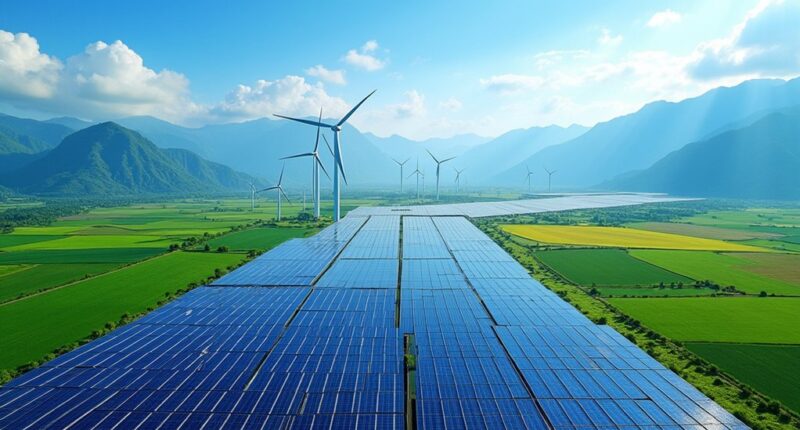China is on a clean energy rampage, pouring billions into renewable resources and hitting impressive capacity milestones. With a whopping $622.5 billion investment in 2024, it leads the charge in solar and wind power, particularly doubling its capacity from 635 GW to 1,408 GW. Meanwhile, as the U.S. contends with policy risks, China’s clean energy advancements not only reshape the global marketplace but also grant it geopolitical leverage. Curious about the broader implications? There’s much more to explore!
Quick Overview
- China’s share of global renewable energy investments stands at 31%, highlighting its significant role in the energy transition.
- The country added 212 GW of solar and 51 GW of wind capacity in the first half of 2025, leading global capacity growth.
- China’s renewable capacity surged to 1,408 GW, doubling in three years and achieving early targets set for 2030.
- The Belt and Road Initiative’s green energy focus includes $9.7 billion in investments, addressing local energy needs and environmental conditions.
- Geopolitically, China’s dominance in renewable energy grants it leverage, while traditional powers struggle to keep pace in the green transition.
Record Investment and Capacity Expansion in Renewable Energy
In a remarkable show of commitment to a cleaner future, global renewable energy investments have soared to an astounding $622.5 billion in 2024, with China leading the charge and accounting for a hefty 31% of this total.
Of this investment pie, utility-scale solar took a whopping 63%, while wind power claimed 35%. Notably, the global renewable capacity additions reached 582 GW in 2024, highlighting the extensive scale of growth. According to recent IEA projections, renewable energy sources will account for over 90% of global electricity expansion in the next five years. China’s rapid expansion saw it add 212 GW of solar and 51 GW of wind capacity in the first half of 2025 alone. Furthermore, China’s wind and solar capacity has doubled from 635 GW to 1,408 GW in just three years, showcasing its aggressive pursuit of renewable energy.
With such colossal figures, it’s clear that China is not just playing catch-up; it’s setting the pace in the global green energy race.
Belt and Road Initiative: Green Energy Focus and Future Prospects
With a world increasingly aware of climate change, the Belt and Road Initiative (BRI) has emerged not just as a global infrastructure project but as a potential green energy game changer.
In the first half of 2025, BRI green energy engagements soared to $9.7 billion, spotlighting wind, solar, and waste-to-energy projects. While the fossil fuel sector still hogs the spotlight with $30 billion, the shift toward renewables is undeniable. Total energy engagements reached an impressive $42 billion, highlighting the growing importance of sustainable investments in the BRI framework. The BRI has cumulatively generated USD 1.308T total since 2013, underscoring its vast potential for transforming energy investment landscapes.
Africa and the Middle East are leading the charge, with Nigeria’s gas revolution making headlines. These regions stand to benefit significantly from implementation considerations that address local environmental conditions and energy needs for optimal renewable system performance. As China capitalizes on its clean-tech expertise, the BRI could redefine energy landscapes globally, one project at a time.
Global Implications of China’s Clean Energy Leadership
A seismic shift in the global energy landscape is underway, largely propelled by China’s ascendance in clean energy leadership.
With emissions dropping and renewable capacity soaring, China is not just playing the game; it’s redefining the rules.
By achieving its 2030 renewable targets early, it’s like finishing a marathon before the starting gun goes off. China installed 360 GW of wind and solar power in 2024, showcasing its commitment to a sustainable future.
As the world’s top manufacturer of solar panels and batteries, China’s innovations have made clean tech more affordable than ever—goodbye, wallet-draining fossil fuels!
This transition represents a crucial step toward addressing climate challenges while creating new economic opportunities in the renewable sector.
This dominance grants China significant geopolitical leverage, leaving traditional powers scrambling to catch up in the race toward a greener future.









